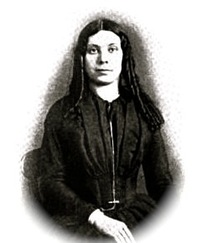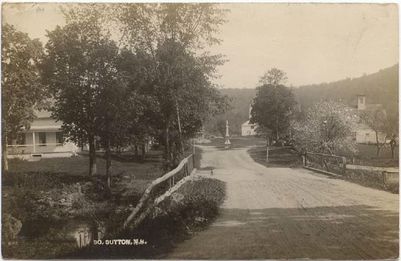Random Facts About Our Hometown~
 Stone walls along road to Wadleigh Homestead from Wadleigh Hill Rd.
Stone walls along road to Wadleigh Homestead from Wadleigh Hill Rd.
Quoting from New Hampshire Beautiful by Wallace Nutting: “We have noted that in the Town of Sutton there are said to be five hundred miles of stone-wall.”[p.93] When were the walls built?
The following quotes are from The History of Sutton, New Hampshire Vol. II by Jack Noon: “…Mathew Harvey in 1798 gave to Theophilus Cram the ‘liberty of making stone wall’…”[p.268] “Mathew Harvey on October 18, 1798… contracted with Benjamin Wells…for having Wells build 18 rods (about 300 ft.) ‘of good stone wall to be built of fair size stones four feet and a half high.’”[p.268] “The urgings from the state Board of Agriculture early in the 1820’s for farmers to end their annual patchwork on fences made from stumps, brush and rails and to build permanent walls of stone made sense.”[p.267] and Jack quoting from Samuel Dresser, Jr.’s journal “October 31, 1825 … Are now building a piece of wall between the old place and the Eaton place.”[p.250]
The following quotes are from The History of Sutton, New Hampshire Vol. II by Jack Noon: “…Mathew Harvey in 1798 gave to Theophilus Cram the ‘liberty of making stone wall’…”[p.268] “Mathew Harvey on October 18, 1798… contracted with Benjamin Wells…for having Wells build 18 rods (about 300 ft.) ‘of good stone wall to be built of fair size stones four feet and a half high.’”[p.268] “The urgings from the state Board of Agriculture early in the 1820’s for farmers to end their annual patchwork on fences made from stumps, brush and rails and to build permanent walls of stone made sense.”[p.267] and Jack quoting from Samuel Dresser, Jr.’s journal “October 31, 1825 … Are now building a piece of wall between the old place and the Eaton place.”[p.250]
 Augusta Harvey Worthen
Augusta Harvey Worthen
The History of Sutton, New Hampshire by Augusta H. Worthen was the first town history in the state prepared by a woman. At the time of its publication in 1891 she was commended for its “thoroughness and literary finish.”
 Horse drawn floats lined up at Horse Beach for the 1897 Midsummer Coaching Parade
Horse drawn floats lined up at Horse Beach for the 1897 Midsummer Coaching Parade
A group of Sutton citizens, mostly owners of inns, guest houses and summer hotels formed the Sutton Carnival Association in the late 1890’s. They sponsored the Midsummer Festival in 1897. One of the highlights of that event was the Coaching Parade. All of the hotels, guesthouses, and etc. had floats that queued up at the Horse Beach at Kezar Lake. The route of the parade took it up to the Huntoon House where it did a fancy maneuver to reverse directions to go back to North Sutton and continue on past Gile Pond to the Shadow Hill House then out to the present day Rt. 114 and back to No. Sutton.
 Lydia Wadleigh
Lydia Wadleigh
Lydia F. Wadleigh (b. Feb. 8, 1817 in Sutton -d. Oct. 27, 1888 in New York City) was one of the most prominent 19th century educators. She taught at schools in New Hampshire, Philadelphia, Washington, D.C. and New Jersey before going to New York City where she established a senior department devoted to the higher education of girls, i.e. she established high school for girls in NYC. In 1870 she became the first lady superintendent (Dean of the College) of the newly established Normal College of New York (Hunter College). NYC honored Lydia by naming its new girls high school (Wadleigh High School for Girls) for her in 1902. The school became co-ed in 1993. Among its alumnae are playwright Lillian Hellman and actresses Jean Stapleton and Isabel Sanford.

During the summer of 1921 Miss Mildred Lefferts was the chaperone for a small group of girls from the Oldfields School who were camping on the Keyser property next to Kezar Lake. The success of this camping trip encouraged Miss Lefferts and her friend Mrs. Scott Clark to start a girls camp. They opened Camp Bueno on the same Keyser property in 1923. Athletics was a focus of the camp and intercamp competitions in a number of sports and games with nearby camps took place during the summer. Trips were made to New Hampshire’s special places, such as Franconia Notch. In 1933 Camp Bueno was the training area for the All American Field Hockey Team before competition abroad. The legacy of Camp Bueno was not just the sports and being out doors, the campers, under Miss Lefferts leadership, developed a strong sense of honor, faith and loyalty. The camp closed in August 1948. Most of the camp property was sold. Miss Lefferts donated the camp’s stained glass window to the church in North Sutton where it is today above the altar.
|
THE GRIST MILL BRIDGE
The wooden bridge spanning the Lane River in South Sutton was replaced by the Town of Sutton in 1901 with a steel and wood bridge manufactured by the American Bridge Co. of Pittsburgh, PA at a cost of $295.00, including $9.00 for grading around the new bridge and removal of the old bridge. The new bridge was replaced in 1932 by one of concrete costing $1,570.97. This figure included moving the steel bridge to Sutton Mills where it replaced the wooden bridge on Grist Mill St. In 1990 Grist Mill Bridge was deemed unsafe for vehicular traffic and was closed. The Town, in 1999, voted to raise $2,500 to replace the vehicle bridge with a pedestrian bridge incorporating the railings from the steel bridge into the new footbridge. |
